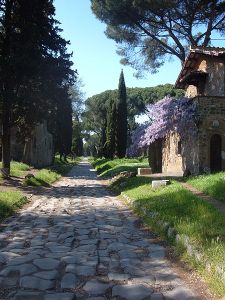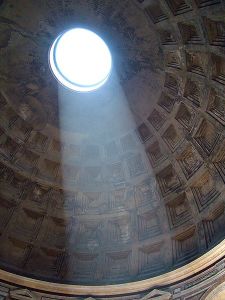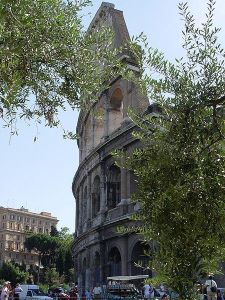
‘What are our woes and sufferance? Come and see
The cypress, hear the owl, and plod your way
O’er steps of broken thrones and temples, Ye!’
Schrijver en dichter George Gordon Byron (1788-1824), beter bekend als Lord Byron, trok na zijn studie de wijde wereld in, waarmee in die tijd vooral de wereld van de grote beschavingen uit het Europese verleden werd bedoeld. Hij zag in Athene hoe Lord Elgin de grote tempel op de Akropolis stripte, reisde door het voormalige Byzantijnse rijk en kwam uiteindelijk, natuurlijk, ook aan in Rome.
De indrukken die hij tijdens deze reis opdeed legde hij vast in Childe Harold’s Pilgrimage. Omdat Lord Byron vandaag zijn 225ste verjaardag zou vieren, gaan we vandaag met hem op stap. Aan de hand van enkele korte dichtregels uit het Canto IV – het deel van Childe Harold’s Pilgrimage dat aan Rome is gewijd – wandelen we samen met Lord Byron Rome binnen, en bekijken het Pantheon en het Colosseum.

Aankomst in Rome
Oh Rome! my country! city of the soul!
The orphans of the heart must turn to thee,
Lone mother of dead empires! and control
In their shut breasts their petty misery.
What are our woes and sufferance? Come and see
The cypress, hear the owl, and plod your way
O’er steps of broken thrones and temples, Ye!
Whose agonies are evils of day
A world is at our feet as fragile as our clay.
(LXXVIII)

Het Pantheon, tempel van alle goden
Simple, erect, severe, austere, sublime
Shrine of all saints and temple of all gods,
From Jove to Jesus – spared and blest by time;
Looking tranquillity, while falls or nods
Arch, empire, each thing round thee, and man plods
His way through thorns to ashes – glorious dome!
Shalt thou not last? Time’s scythe and tyrants’ rods
Shiver upon thee – sanctuary and home
Of art and piety – Pantheon! – pride of Rome!
(CXLVI)

‘This magic circle’: het Colosseum
But when the rising moon begins to climb
Its topmost arch, and gently pauses there;
When the stars twinkle through the loops of time,
And the low night-breeze waves along the air
The garland-forest, which the gray walls wear,
Like laurels on the bald first Cæsar’s head;
When the light shines serene but doth not glare,
Then in this magic circle raise the dead:
Heroes have trod this spot – ‘tis on their dust ye tread.
(CXLIV)
‘While stands the Coliseum, Rome shall stand;
‘When falls the Coliseum, Rome shall fall;
‘And when Rome falls – the World.’ From our own land
Thus spake the pilgrims o’er this mighty wall
In Saxon times, which we are wont to call
Ancient; and these three mortal things are still
On their foundations, and unalter’d all;
Rome and her Ruin past Redemption’s skill,
The World, the same wide den – of thieves, or what ye will.
(CXLV)
> Meer lezen over wat Lord Byron in Rome allemaal zag? Bekijk dan de website van Rome Artlover!
